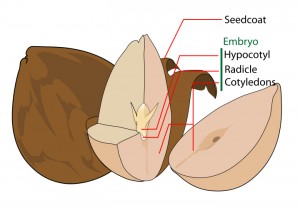Seeds come in many shapes and sizes. They can be as big as coconuts or as small as orchid seeds that are carried by the wind. Size usually depends on how the seed is dispersed.
Big or small they all have three things in common related to their structure:
1) Hard protective shell outside called the seed coat;
2) Dormant embryo inside;
3) Nutrition (stored food) to keep it viable. Viable means that the seed is capable of germinating when you plant it. If it is not viable the nutrition inside has been used up and the embryo will no longer develop. Much of seed viability depends upon storage conditions. Ideal conditions would be somewhere cool and dry (e.g. a capped jar in the refrigerator).
When a seed is planted in the ground, container, or any growing medium there are four environmental factors that affect germination:
1) Moisture – Germination begins with the absorption of water. It ends when the seedling is self-sustaining. During that period, the growing medium should stay evenly moist (like a wrung-out sponge) and never dry out.
2) Temperature – Seeds like warmth. Generally, 65-75 F is best for most plants. The back of the seed pack will list the desired temperature range.
3) Oxygen – Respiration takes place in all viable seeds. During germination, the respiration rate increases. Soil or growing medium needs to be loose and well aerated.
4) Light – Some seeds require light, some seeds require darkness, and for some seeds it doesn’t matter. The back of the seed pack will list any special lighting requirement.
Ideal characteristics of growing medium include the following:
1) Fine and uniform texture;
2) Well aerated and loose;
3) Free of insects, disease, and weed seeds;
4) Low in total soluble salts;
5) Able to hold moisture yet drain well.
If sowing seeds indoors in containers think about recycling egg and milk cartons, plastic soda and water bottles, or pie pans. Just remember to create holes in the bottom for drainage.
Seed Sowing Tips
1) Depth matters – Problems can arise if too shallow or too deep. In general sow seeds 4 times the smallest dimension (see seed packet).
2) In soil or in a pot? Sow big seeds like sunflower, nasturtium, corn, peas in soil where they’ll grow. Sow small seeds like broccoli, oregano, snapdragons in containers.
3) Re-sow seeds, especially of vegetables, every 3-4 weeks for continuously developing new plants. This will provide sequential food crops to harvest. Plant lettuce in September, October, November and December, and you’ll have lettuce the entire school year.
Seed Diagram (Avocado)


Pingback: Starting from Seed | School Garden Weekly
nice